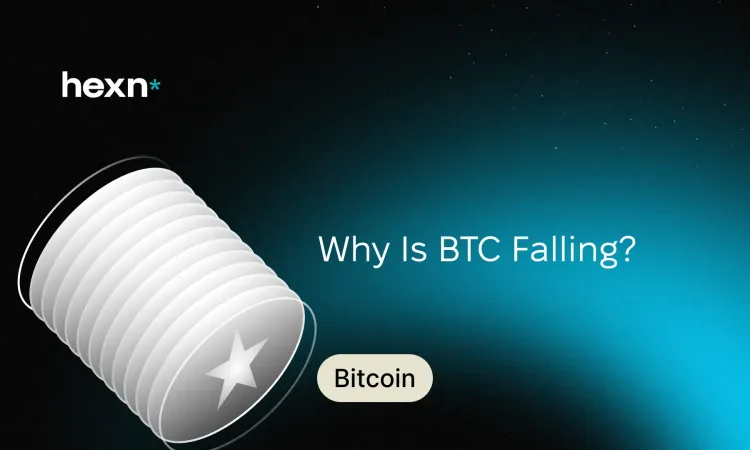Bitcoin Today: Why Is BTC Falling? Outlook and ETF Impact
The BTC price reacts quickly to liquidity flows, ETF headlines, and overall market sentiment. Below is a brief breakdown of why the price may be declining right now, how spot and futures ETFs affect it, and which entry tactics can help you reduce risk.
What Moved BTC This Week: Liquidity, Spreads, Volumes
When the market is “thin,” even medium-sized orders have a disproportionate impact. That’s why it’s important to watch not only price but also the quality of the order book and the true cost of execution.
Liquidity. A thin order book amplifies every move: large orders “push through” the price more than usual. Watch book depth and iceberg orders—these directly affect slippage. Institutional research repeatedly highlights the relationship between order-book depth and actual execution costs.
Spreads. Widening bid/ask spreads and cross-exchange basis are signs of nervousness. For tactical entries, this raises the cost of being wrong. In practice, when liquidity deteriorates, spreads widen even on “top” markets.
Volumes. A decline on rising volume often looks like capitulation; a decline on low volume looks more like being “pushed” through a narrow book. Compare this week’s volumes to 20–30-day averages and to liquid trading hours.
Leverage and liquidations. Rising open interest and positive funding rates on perpetual futures often precede waves of long liquidations; the reverse sets up short squeezes. This accelerates intraday volatility and strengthens impulses.
The Role of Spot and Futures ETFs: Inflows/Outflows and Volatility
Over the past year, spot Bitcoin ETFs have become an important channel of demand and supply. It’s crucial to track not only the total inflows/outflows but also their concentration by day and hour.
Spot ETFs
Inflows imply net buying of the underlying; outflows create selling pressure. On heavy-flow days, intraday volatility typically rises and spreads widen. Daily flow tables for major U.S. ETFs (IBIT, FBTC, etc.) make it easy to spot spikes by date—including in late October and early November 2025.
How it works technically. The primary/secondary market mechanism (creation/redemption of baskets) explains why large net flows matter more than ordinary exchange trading “between investors.”
Futures ETFs
They operate through derivatives and primarily affect the basis (the futures/spot spread) and funding. CME data and specialist reviews show that the basis structure and sentiment often move together: a positive impulse brings a positive basis (contango), while aggressive sell-offs cause compression or a negative basis.
Why Bitcoin Is Falling — A Checklist of Reasons
When price moves lower, it’s rarely just one culprit. It’s usually a combination of macro background, liquidity, participant positioning, and fund flows.
Macro and the dollar. Rising U.S. Treasury yields and phases of dollar strength traditionally weigh on risk assets; at the same time, BTC’s relationship with DXY has historically varied from phase to phase and can be weaker than the “classic” correlation. Track rate/inflation headlines and how ETF flows react to them.
Crypto market liquidity. Liquidity compression on spot, stablecoin outflows, and reduced market-maker activity increase price sensitivity. During rebalancing windows or earnings releases, sellers often “cluster” in time—this accelerates moves.
Mining and the network. After the halving, structural selling pressure from miners decreased; however, under stress scenarios (rising costs, falling price) sales can increase. Network and miner-market reports in 2025 note both hashrate growth to around ~1 ZH/s and episodes of elevated coin outflows from miner addresses.
Positioning. Overbought technicals, high open interest, and consistently positive funding rates increase the vulnerability of longs to sharp flushes. Conversely, negative funding and an “overcrowded” short side raise the risk of a short squeeze.
Entry in Practice: Limit Orders, Tranches, and Risk Discipline
The goal is to lower execution costs and protect against bad scenarios. Combine execution quality with position management.
Using limit orders
Limit orders reduce slippage when spreads are wide and let you place a price where the risk/reward is clear. Market-impact research shows execution costs rise sharply in thin markets—another argument for limits and careful timing.
Tranching
Split the position into 3–5 parts by price/time: a “ladder” near market and at deeper liquidity levels. Link tranche size to volatility: the “faster” the day, the smaller each clip. This helps you ride out intraday impulses from ETF flows and derivatives.
Insurance against worst-case scenarios
Lock in your exit plan before entry: stop level, partial take-profit, and conditions for canceling remaining tranches. Avoid impulsive market buys during “thin” hours and around news windows/periods of elevated ETF activity.
Quick Pre-Trade Checklist
- I understand today’s drivers: liquidity/volumes/basis.
- I checked ETF flows: were there spikes in inflows/outflows and at what hours?
- I have a tranching plan and conditions to cancel orders.
- I know my exit if I’m wrong (stop) and where I’ll take partial profits if I’m right (take-profit).
- Position size fits portfolio risk; fees and taxes are accounted for.
Conclusion
Short-horizon BTC moves are the sum of factors: liquidity, spot/futures ETF flows, macro background, and positioning. Reduce risk with discipline: plan entries in advance, split positions into tranches, use limit orders, and keep a clear stop. Track hours of active ETF flows and the derivatives basis—your decisions will be calmer and your mistakes cheaper.
To earn returns with minimal risk, use Hexn’s fixed-income deposits offering up to 20% APY.
